Biodiversity focus on a seamount graveyard, New Zealand
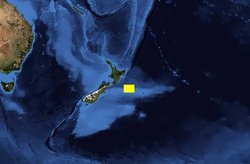 New Zealand graveyard. (Source: National Institute of Water and Atmospheric Research, New Zealand)
New Zealand graveyard. (Source: National Institute of Water and Atmospheric Research, New Zealand) Seamounts (or undersea mountains) are ubiquitous features of the world’s underwater topography; globally there are estimated to be up to 100,000 seamounts over 1 km high (100 of which are in the New Zealand region) and many more of smaller elevation.
Seamounts may play an important role in patterns of marine biogeography, are often highly productive ecosystems, and act as feeding grounds for fishes, marine mammals and seabirds. Globally, seamount biodiversity is poorly known (less than 200 have been studied in any detail) however, their economic value is well documented – seamounts are the focus for offshore commercial fishing, and of potential interest for seabed mining. This conflict of interests has been borne out in the media and New Zealand may provide a case study in compromise – conservation vs. exploitation.
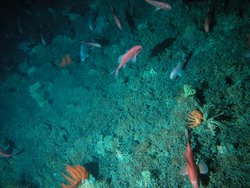 Coral community. (Source: National Institute of Water and Atmospheric Research, New Zealand)
Coral community. (Source: National Institute of Water and Atmospheric Research, New Zealand) Seamounts can support high biodiversity and special biological communities (including fragile animals such as corals and sponges), with high levels of endemic (only found in a particular region) species on some seamounts. The Graveyard seamount complex is a group of seamounts located on the northern flank of on New Zealand’s Chatham Rise and host to diverse biological communities. Extensive coral growths (e.g. Solenosmilia variabilis and Madrepora oculata) have been observed on Graveyard seamounts, which in turn offer refugia for a great many other invertebrates (including squat lobsters, seastars, brittlestars, crabs) and fish within, or in association with, the living and dead coral framework.
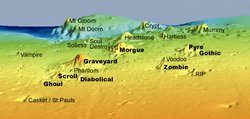 Seamount Graveyard. (Source: National Institute of Water and Atmospheric Research, New Zealand)
Seamount Graveyard. (Source: National Institute of Water and Atmospheric Research, New Zealand) The Graveyard is home to over 50 fish species, but dominated by orange roughy, oreos, various deepwater sharks, and cardinalfish. There is an important commercial trawl fishery on the Graveyard for orange roughy (Hoplostethus atlanticus). The first reported catches in the area were taken in 1979, but the fishery on the seamount itself didn’t start in earnest until the early 1990s. By 2007, nearly 30 years after the fishery started, a total of over 18 000 t of orange roughy had been caught, and the fishery remains substantial (about 1000 t per year). The Graveyard has therefore been the site of one of the most persistent orange roughy fisheries in the world. Whilst some orange roughy are believed to be resident on the Graveyard, the majority visit the area only in June and July to spawn, during which time they form large spawning aggregations (‘plumes’) close to the summit of the seamount. More than half of the commercial catch is usually taken just before and during the spawning period. The commercial catch of orange roughy is restricted by a quota, which is set at a level believed to be low enough to ensure the fishery remains sustainable.
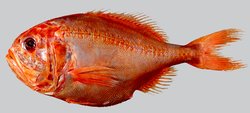 Orange Roughy. (Source: National Institute of Water and Atmospheric Research, New Zealand)
Orange Roughy. (Source: National Institute of Water and Atmospheric Research, New Zealand) As well as affecting community composition through direct harvest, the heavy trawl gear associated with fishing demersal species (such as orange roughy) has a direct physical impact on the seabed and associated fauna. Several researchers have reported physical evidence of trawling in Australian and New Zealand waters. Community composition has been shown to vary between fished and un-fished seamounts in the Graveyard complex, with fished seamounts supporting less coral reef, which in turn may cause differences in the invertebrate assemblages of fished vs. unfished seamounts.
By the late 1990s, the New Zealand Ministry of Fisheries started to develop a Seamount Management Strategy in response to its legal obligations to consider damage to the habitat by fishing, as well as growing awareness and concern worldwide that bottom trawling could have marked impacts on benthic fauna.
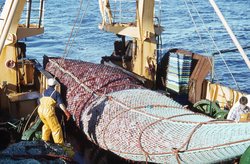 Landing catch. (Source: National Institute of Water and Atmospheric Research, New Zealand)
Landing catch. (Source: National Institute of Water and Atmospheric Research, New Zealand) In 2001, 19 New Zealand seamounts were closed to all bottom trawling, midwater trawling, and dredging – three of these closed seamounts were in the Graveyard complex (Morgue, Pyre and Gothic). The closures have provided an ideal basis for numerous ecological experiments on the effects of fishing. Morgue was moderately trawled before the closure, and now the post-closure recovery is being monitored. Furthermore seamount communities on lightly/never fished seamounts (Pyre and Gothic) remain preserved and can be compared with seamounts still maintaining a fishery, e.g. the heavily fished Graveyard seamount.
Research in the deep-sea remains a challenge, both with the logistics and economic cost of sampling as well as the slow growth rates of many deep-sea fauna (e.g. corals, orange roughy). However, with increasingly multi-disciplinary approaches to sampling seamounts, using ever improving technologies (e.g. submersibles, towed camera platforms) an increased understanding of these ecosystems can only serve to better inform managers and policy makers.
Further Reading
- Clark, M.R., 2001. Are deepwater fisheries sustainable? The example of orange roughy. Fisheries Research, 51:123–135.
- Clark, M. and R. O’Driscoll, 2003. Deepwater fisheries and aspects of their impact on seamount habitat in New Zealand. Journal of Northwest Atlantic Fishery Science, 31:441–458.
- Clark, M.R., Tittensor, D., Rogers, A.D., Brewin, P., Schlacher, T., Rowden, A., Stocks, K., Consalvey, M., 2006. Seamounts, deep-sea corals and fisheries: vulnerability of deep-sea corals to fishing on seamounts beyond areas of national jurisdiction. UNEP-WCMC, Cambridge, UK.
- Koslow, J.A., Gowlett-Holmes, K., Lowry, J.K., O’Hara, T., Poore, G.C.B. and A. Williams, 2001. Seamount benthic macrofauna off southern Tasmania: community structure and impacts of trawling. Marine Ecology Progress Series, 213:111–125.
- Rowden, A.A. and Clark, M., 2004. Uncovering secrets of our seamounts. Water and Atmosphere, 12:22- 23.
- Ministry of Fisheries, Science Group (Comps.), 2006. Report from the Fishery Assessment Plenary, May 2006: stock assessments and yield estimates. 875 p. (Unpublished report held in NIWA library, Wellington.)